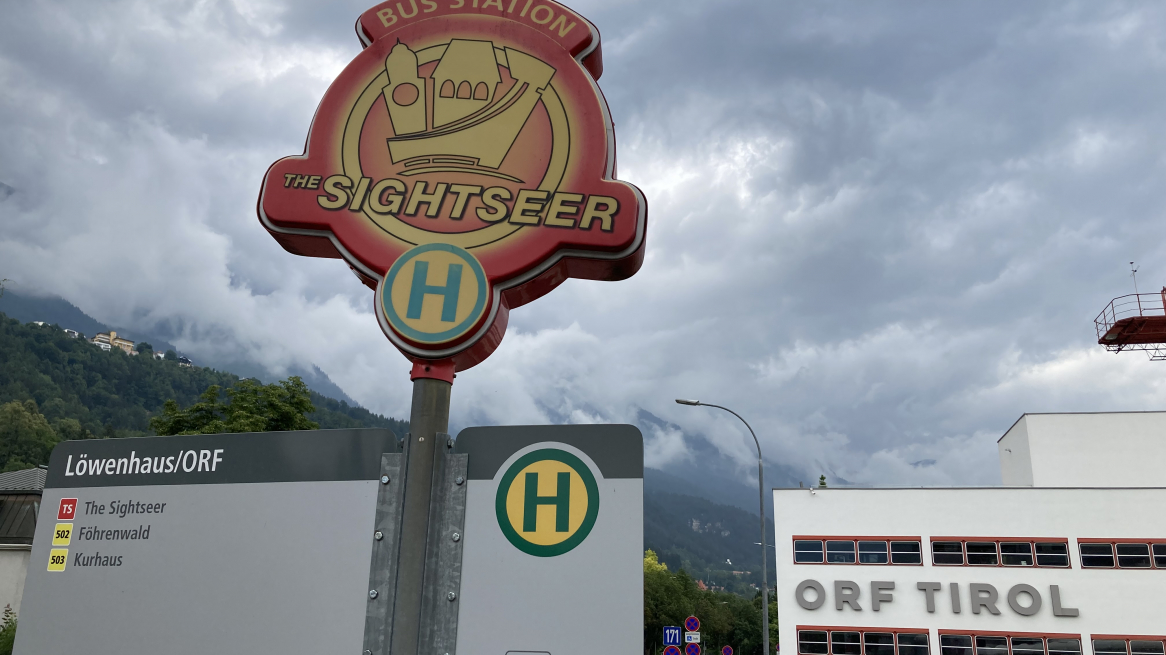
I've lived in Innsbruck for over twelve years now. Having seen the Sightseer signs at bus stops throughout the city, I've often wondered about taking a guided bus tour, and my two sons - aged 9 and 4 - seemed pretty keen on the idea too.
It felt like a nice way to while away a few hours on a cloudy, drizzly day (with the occasional sunny spell) so we headed for our nearest Sightseer stop - Löwenhaus/ORF (ORF is the Austrian equivalent of the UK's BBC, and Löwenhaus - literally 'Lions house' - is a restaurant which closed down a few years ago but provides the name for the stop of the Hungerburgbahn that takes you up to Seegrube and the mighty 'Nordkette' mountain range).
The ticket for the sightseer bus is valid for 24 hours after first use and you can hop on and hop off as many times as you like. We had some time until our next bus - they are forty minutes apart - so we went to watch the Hungerburbahn train and took some photos.
The Grand Tour begins
We boarded and popped our headphones on. There is a choice of eight languages - German, English, Italian, French, Dutch, Spanish, Japanese and Arabic, with a kids audio guide option for each language too.
The tour took us through our home district of Saggen towards the Pradl district. The audio guide told us that Pradl was a village separate to Innsbruck until the twentieth century. This is despite it being close to the centre of the city. You can still see the occasional farm building in the area - there are remnants of village and country life scattered thoughout the city, which provide a fascinating juxtaposition.
Southside
Then it was on past the Tivoli outdoor swimming area, a popular summer bathing spot, and on to the Tivoli stadium, home to the (sadly, at this moment, not so mighty) FC Wacker Innsbruck. The Austrian national team also occasionally plays friendly matches at the ground. It was here that the audio guide told us a bit about the history of sport in Innsbruck, which included the fact that the city twice hosted the Winter Olympics - 1964 and 1976.
Next it was up the road to Schloss Ambras, and the site of a renaissance castle which houses a fascinating museum. This is well worth a visit. Judging by the number of people of who boarded at this stop it seems many had taken the audio guide advice to explore the castle and its grounds.
Heading back west gives passengers views of the famous Bergisel ski jump, designed by the world renowned British-Iraqi architect Zaha Hadid.
Unfortunately, taking photos was difficult with my four year old demanding to sit on my lap.
The bus then took us up towards the Bergisel and our next stop, the Tirol Panorama museum. This is the site at which no less than three times, Tirolean folk hero Andreas Hofer gathered a militia to defeat the combined might of the Bavarian and Napoleon's French armies. The museum is great (I took my parents there for a visit a few years back). Its undoubted centrepiece is the giant panoramic painting depicting Hofer's third victory in 1809. The painting is over 1000 square meters and features a remarkable level of detail.
There was a fifteen minute break here so we got out to admire the magnificent views over the city and look at the Andreas Hofer statue.
Back to the centre
The bus then heads down the hill into the heart of Innsbruck's Wilten district, past Wilten Abbey and the Grassmayr bell museum and foundry. The Grassmayr family have been making bells since 1599, making it Austria's oldest family-run business.
After our excursion to the southside, the bus trundles towards the city centre. The traffic means our pace has slowed right down but that's actually a good thing as there's lots to see - the Triumphpforte monument, the bustling Maria-Theresien-Strasse - and lots of interesting information to take in. Then it's over the river we go.
The audio guides are excellent, full of fascinating facts. For instance, Innsbruck's tap water is of renowned quality, coming freshly sourced from the Nordkette mountain range. But the remarkable thing is that the water pressure is so high, there's a steady supply able to reach the top floors of the highest buildings without the use of pumps.
The music between the commentary has a distinctly local flavour, ranging from the Wilten boys choir to acclaimed Tirolean percussionist Manu Delago.
After a brief detour though the Mariahilf district with its distinctively coloured houses (which provide an excellent photo opportunity from the Market square opposite) we cross the Innbrücke, the bridge that gives the city its name. Then we skirt around the Old Town, taking in the Golden Roof to our left as we drive up Museumstrasse.
We then pass the Hofburg to the left, the new Haus der Musik (house of music) and Landestheater to the right and we're back alongside the river Inn for the final stretch of our circuit.
The giant knitting needle-like towers of the bridge at the Löwenhaus stop of the Hungerburgbahn signal that we've come full circle. We thank the driver, and hop off back at the ORF, roughly one hour and twenty minutes after boarding.
'That was really interesting!' declares my nine year old son, completely unprompted. Recommendations don't come much better than that.
Rate this article
Show me the location on the map
Welsh-born father of two boys. Innsbruck resident since 2009.
Similar articles
The museum in Innsbruck's Arsenal "Museum im Zeughaus" was reopened on April 6,…
The Ferdinandeum regional museum is open until June 30, 2024, with exhibitions and events. Then a…
A purely Tyrolean film project aims to shed new light on the novel story of probably…
With the Alpine Jitterbugs, Innsbruck has a club that is passionately dedicated to swing dancing. The Alpine…













